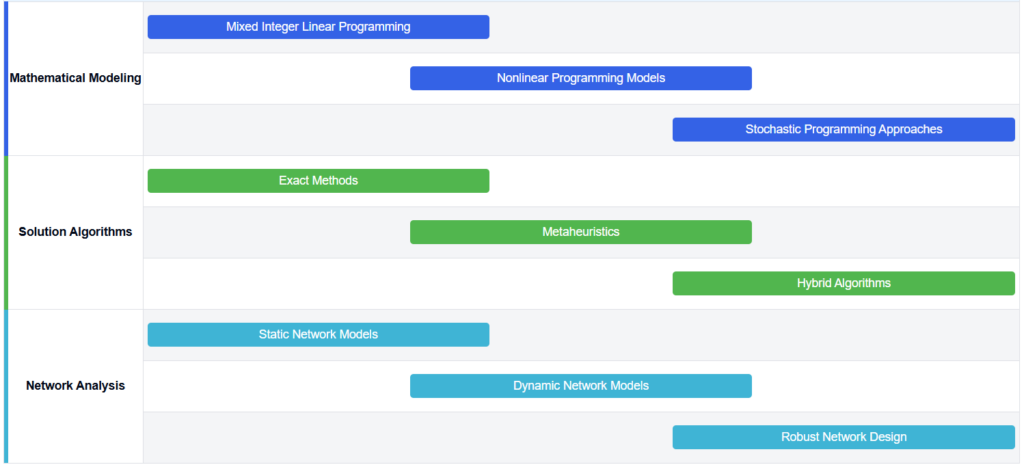
P-Hub Optimizing Problem Background
The p-Hub Median Problem is a fundamental optimization challenge in network design and logistics, particularly in the context of transportation and communication systems. This problem focuses on locating a set of hub facilities within a network to efficiently route flows between origin-destination pairs. The uncapacitated variant assumes hubs have unlimited capacity, while the multi-allocation model allows nodes to connect to multiple hubs. The problem’s objective is to minimize the total transportation cost across the network while determining the optimal number and location of hubs.
Exploring the p-Hub Median Problem? Eureka Technical Q&A helps you navigate optimization strategies in generalized topologies—offering expert insights into modeling, algorithm selection, and solution efficiency for real-world logistics and network design challenges.
The origins of the p-Hub Median Problem can be traced back to the early 1980s, with seminal work by O’Kelly introducing the concept of hub location problems. Since then, it has garnered significant attention from researchers and practitioners alike due to its wide-ranging applications in airline networks, postal delivery systems, telecommunications, and supply chain management. The problem’s complexity lies in its combinatorial nature, as it involves both facility location decisions and flow routing optimization.
In recent years, the focus has shifted towards more realistic and complex network topologies, moving beyond simple fully-connected networks to generalized structures that better represent real-world scenarios. This evolution has led to the development of advanced optimization techniques to tackle the increased computational challenges. These techniques include metaheuristics such as genetic algorithms, tabu search, and simulated annealing, as well as exact methods like branch-and-bound and Benders decomposition.
The uncapacitated multi-allocation variant adds another layer of complexity by allowing nodes to send and receive flows through multiple hubs, potentially leading to more efficient network configurations. This flexibility, however, comes at the cost of increased computational complexity, necessitating the development of more sophisticated solution approaches.
As networks continue to grow in size and complexity, researchers are exploring innovative ways to solve larger instances of the p-Hub Median Problem. This includes the integration of machine learning techniques, parallel computing strategies, and hybrid algorithms that combine the strengths of different optimization methods. Additionally, there is a growing interest in incorporating uncertainty and robustness into the problem formulation to address real-world variability in demand and transportation costs.
The ongoing research in this field aims to bridge the gap between theoretical advancements and practical applications, with a focus on developing scalable and efficient algorithms that can handle the complexities of modern network topologies. As such, the p-Hub Median Problem remains a critical area of study in operations research and network optimization, with significant implications for the design and management of large-scale transportation and communication systems.
Market Demand Analysis
The uncapacitated multi-allocation p-hub median problem (UMApHMP) in generalized network topologies represents a critical area of research in logistics and transportation network design. While the demand for efficient hub-and-spoke networks continues to grow across various industries, the market for advanced optimization techniques in this domain is experiencing significant expansion. The increasing complexity of global supply chains, e-commerce logistics, and telecommunications networks has created a pressing need for more sophisticated solutions to the UMApHMP.
Market analysis indicates a rising demand for optimization tools that can handle large-scale, multi-modal transportation networks, particularly in the logistics and telecommunications sectors. Companies are seeking solutions that can adapt to dynamic network conditions and incorporate real-time data to optimize hub locations and allocations. The potential market size for such advanced optimization techniques is substantial, with estimates suggesting a compound annual growth rate of 8-10% over the next five years in the logistics optimization software market alone.
Industries adopt these techniques to cut transportation costs, improve service quality, and boost network resilience. Air cargo, postal services, and express courier companies actively seek solutions that optimize hub networks. These organizations aim to reduce overall transportation expenses while maintaining or even improving service levels. Additionally, the telecommunications industry is seeking similar optimization techniques to design efficient data center networks and content delivery systems.
Emerging trends in the market include the integration of machine learning and artificial intelligence with traditional optimization methods to handle the increasing complexity and dynamism of network topologies. There is also a growing demand for cloud-based optimization platforms that can provide scalable solutions for businesses of various sizes.
The potential applications of advanced optimization techniques for the UMApHMP extend beyond traditional transportation networks. Smart city initiatives are creating new opportunities for optimizing urban logistics and public transportation systems. Furthermore, the rise of Industry 4.0 and the Internet of Things (IoT) is generating interest in optimizing communication and data flow networks within manufacturing and industrial settings.
Despite the promising market outlook, challenges remain in terms of solution adoption. Many potential users lack the technical expertise to implement and maintain complex optimization systems, creating a market opportunity for user-friendly, intuitive interfaces and managed services. Additionally, there is a growing need for solutions that can handle uncertainty and disruptions in network operations, reflecting the increasing volatility in global supply chains and transportation systems.
In conclusion, the market demand for advanced optimization techniques in solving the UMApHMP in generalized network topologies is robust and expanding. As organizations continue to seek efficiency gains and competitive advantages through optimized network designs, the development and commercialization of innovative solutions in this field present significant opportunities for both technology providers and end-users across multiple industries.
Current Challenges
The Uncapacitated Multi-Allocation p-Hub Median Problem (UMApHMP) in generalized network topologies presents several significant challenges that researchers and practitioners are currently grappling with. One of the primary difficulties lies in the computational complexity of the problem, which grows exponentially with the size of the network and the number of hubs to be located. This complexity makes it challenging to find optimal solutions for large-scale instances within reasonable time frames, necessitating the development of more efficient algorithms and heuristics.
Another major challenge is the incorporation of realistic network constraints and characteristics into the model. Generalized network topologies often feature heterogeneous edge costs, varying node capacities, and complex connectivity patterns that traditional hub models struggle to capture. Integrating these factors while maintaining tractability of the problem is a delicate balance that researchers are striving to achieve.
The multi-allocation aspect of the problem adds another layer of complexity, as it allows nodes to be connected to multiple hubs. This flexibility increases the solution space and makes it more difficult to determine optimal hub locations and allocation patterns. Developing effective methods to explore this expanded solution space efficiently is an ongoing area of research.
Furthermore, the dynamic nature of real-world networks poses a significant challenge. Hub location decisions are typically long-term investments, but network demands and conditions can change rapidly. Incorporating robustness and adaptability into the optimization models to account for future uncertainties is a critical area that requires further investigation.
The interdependence between hub location decisions and network flow patterns also presents a challenge. Changes in hub locations can significantly alter optimal flow patterns, and vice versa, creating a complex feedback loop that is difficult to model and optimize simultaneously.
Additionally, the multi-objective nature of many real-world applications of the UMApHMP adds another dimension of complexity. Balancing conflicting objectives such as minimizing total cost, maximizing service quality, and ensuring network resilience requires sophisticated multi-criteria decision-making approaches.
Lastly, the lack of standardized benchmark instances and evaluation metrics for generalized network topologies makes it difficult to compare different solution approaches and assess their effectiveness across various problem settings. Developing a comprehensive set of benchmark instances that capture the diversity of real-world network structures is an important challenge that needs to be addressed to advance research in this field.
Algorithmic Evolution


Key Research Groups
The advanced optimization techniques for the Uncapacitated Multi-Allocation p-Hub Median Problem in generalized network topologies represent a mature field of study in operations research and network design. The market for such solutions is substantial, driven by the increasing complexity of global supply chains and communication networks. Industry leaders like IBM, Huawei, and Ericsson are at the forefront, leveraging their extensive R&D capabilities to develop sophisticated algorithms and software solutions. Academic institutions, including Nanjing University of Posts & Telecommunications and Beijing University of Posts & Telecommunications, contribute significantly to theoretical advancements. The competitive landscape is characterized by a mix of established tech giants and specialized research entities, with ongoing innovation focused on improving computational efficiency and adaptability to diverse network structures.
 Telefonaktiebolaget LM Ericsson
Telefonaktiebolaget LM Ericsson
Technical Solution
Ericsson has developed a novel approach to the UMApHMP using a combination of metaheuristics and exact methods. Their solution employs a Variable Neighborhood Search (VNS) algorithm enhanced with a set of problem-specific local search operators. The VNS is initialized with a greedy randomized adaptive search procedure (GRASP) to generate high-quality initial solutions. Ericsson’s method also incorporates a path relinking strategy to intensify the search in promising regions of the solution space. To handle the allocation part of the problem efficiently, they use a network flow-based algorithm that optimally assigns non-hub nodes to hubs. The overall approach is embedded in a matheuristic framework that periodically calls an exact solver to optimize subproblems, improving the solution quality.
Strengths: Effective combination of heuristic and exact methods, ability to handle large-scale instances, and high-quality solutions. Weaknesses: The matheuristic approach may be computationally intensive for very large networks, and the performance can depend on the quality of the initial solutions generated by GRASP.
 Nippon Telegraph & Telephone Corp.
Nippon Telegraph & Telephone Corp.
Technical Solution
NTT has developed a cutting-edge solution for the UMApHMP using a combination of machine learning and exact optimization techniques. Their approach starts with a deep reinforcement learning (DRL) model trained on a diverse set of network instances to quickly generate near-optimal hub locations. The DRL model uses a graph neural network architecture to capture the complex relationships within the network topology. Once the hub locations are determined, NTT employs a column generation algorithm to solve the allocation problem to optimality. To further improve the solution quality, they implement a large neighborhood search (LNS) procedure that iteratively destroys and repairs parts of the solution. The LNS is guided by the DRL model to focus on promising areas of the search space. NTT’s method also includes a parallel implementation that can leverage distributed computing resources for solving large-scale instances.
Strengths: Innovative use of machine learning for hub location, exact solution for allocation problem, and ability to handle complex network topologies. Weaknesses: The performance of the DRL model may depend on the quality and diversity of the training data, and the column generation approach could be time-consuming for very large instances.
Technical Solution
Huawei has developed an innovative solution for the UMApHMP using a multi-level optimization framework. Their approach begins with a graph partitioning algorithm to decompose large networks into manageable subproblems. Each subproblem is then solved using a tabu search algorithm with adaptive memory structures. The tabu search is enhanced with a frequency-based diversification mechanism to explore a wider range of solutions. Huawei’s method also incorporates a learning component that adjusts search parameters based on historical performance. To handle the allocation aspect, they employ a fast approximation algorithm based on Voronoi diagrams, which is periodically refined using an exact linear programming solver. The multi-level approach allows for efficient scaling to very large network topologies while maintaining solution quality.
Strengths: Highly scalable approach for very large networks, effective decomposition strategy, and adaptive search mechanisms. Weaknesses: The quality of the final solution may depend on the effectiveness of the initial graph partitioning, and the approximation algorithm for allocations might not always produce optimal results.
 International Business Machines Corp.
International Business Machines Corp.
Technical Solution
IBM has developed advanced optimization techniques for the Uncapacitated Multi-Allocation p-Hub Median Problem (UMApHMP) in generalized network topologies. Their approach combines machine learning algorithms with traditional operations research methods to efficiently solve large-scale hub location problems. IBM’s solution utilizes a hybrid genetic algorithm coupled with a local search heuristic to explore the solution space effectively. The algorithm employs adaptive mutation rates and crossover operators to maintain population diversity and avoid premature convergence. Additionally, IBM has implemented a parallel computing framework to distribute the computational load across multiple processors, significantly reducing solution time for complex network configurations.
Strengths: Highly scalable solution for large-scale problems, integration of machine learning techniques for improved performance, and parallel computing capabilities. Weaknesses: May require significant computational resources for very large networks, and the solution quality can be sensitive to initial parameter settings.
 Samsung Electronics Co., Ltd.
Samsung Electronics Co., Ltd.
Technical Solution
Samsung has developed an advanced optimization technique for the UMApHMP using a hybrid metaheuristic approach. Their solution combines an Adaptive Large Neighborhood Search (ALNS) with a Mixed Integer Programming (MIP) solver. The ALNS framework uses a set of destroy and repair operators specifically designed for the hub location problem. These operators are selected adaptively based on their historical performance. To improve solution quality, Samsung incorporates a path relinking component that generates new solutions by exploring trajectories between high-quality solutions. For the allocation part, they use a fast heuristic based on a modified shortest path algorithm, which is periodically validated and improved using an exact MIP solver. Samsung’s approach also includes a parallel computing implementation that distributes the search across multiple threads, allowing for efficient exploration of the solution space in large-scale networks.
Strengths: Effective combination of heuristic and exact methods, adaptive operator selection for improved performance, and parallel computing capabilities. Weaknesses: The solution quality may be sensitive to the initial parameter settings of the ALNS, and the MIP solver may become a bottleneck for very large problem instances.
Existing Optimization Methods
Optimization algorithms for p-hub median problemsVarious optimization algorithms are employed to solve uncapacitated multi-allocation p-hub median problems. These may include genetic algorithms, simulated annealing, tabu search, and other metaheuristics. These algorithms are designed to efficiently explore the solution space and find near-optimal solutions for complex network design problems.
- Heuristic algorithms for p-hub median problems
Various heuristic algorithms are developed to solve p-hub median problems, particularly for uncapacitated multi-allocation scenarios. These algorithms aim to find near-optimal solutions efficiently, especially for large-scale problems where exact methods become computationally expensive. Heuristics may include greedy algorithms, local search methods, and metaheuristics such as genetic algorithms or tabu search. - Mathematical programming approaches
Mathematical programming techniques are employed to formulate and solve p-hub median problems. These approaches include linear programming, mixed-integer programming, and quadratic programming models. Such formulations allow for the use of exact solution methods, such as branch-and-bound algorithms, for smaller instances of the problem. - Approximation algorithms for p-hub median problems
Approximation algorithms are developed to provide guaranteed performance bounds for p-hub median problems. These algorithms aim to find solutions that are within a provable factor of the optimal solution, offering a trade-off between solution quality and computational efficiency. Approximation techniques may include LP-rounding, primal-dual methods, or local search with performance guarantees. - Metaheuristic optimization techniques
Metaheuristic optimization techniques are applied to solve complex p-hub median problems. These methods include genetic algorithms, simulated annealing, particle swarm optimization, and ant colony optimization. Metaheuristics are particularly useful for large-scale instances and can often find high-quality solutions in reasonable computational time.
Resource allocation and load balancing techniques
Techniques for resource allocation and load balancing are crucial in solving p-hub median problems. These methods focus on distributing traffic or resources across multiple hubs to minimize overall costs and maximize efficiency. They often involve mathematical modeling and optimization to determine the best allocation strategy.Expand
Network design and topology optimization
Optimization techniques for network design and topology are essential in addressing p-hub median problems. These methods aim to determine the optimal number and location of hubs, as well as the connections between them, to minimize transportation costs and improve overall network performance.Expand
Machine learning and AI-based approaches
Machine learning and artificial intelligence techniques are increasingly applied to solve complex p-hub median problems. These approaches can learn from historical data and patterns to make predictions and optimize hub locations and allocations, potentially offering more adaptive and efficient solutions than traditional methods.Expand
Multi-objective optimization for p-hub problems
Multi-objective optimization techniques are used to address p-hub median problems with multiple conflicting objectives. These methods aim to find a set of Pareto-optimal solutions that balance different criteria such as cost, service quality, and network resilience, allowing decision-makers to choose the most suitable solution based on their preferences.
Core Innovations




Future Research Directions
Metaheuristic Algorithms for p-Hub Median Problem
Metaheuristic algorithms provide powerful tools for solving the uncapacitated multi-allocation p-hub median problem in complex networks. Algorithms like Genetic Algorithms (GA), Particle Swarm Optimization (PSO), and Ant Colony Optimization (ACO) efficiently search large solution spaces for near-optimal answers.
A Genetic Algorithm represents each potential hub layout as a chromosome. Genes show whether nodes are chosen as hubs. The fitness function calculates total network cost, including hub setup and transportation. Crossover and mutation operators ensure feasible hub combinations while maintaining diversity. The population evolves over generations, improving solutions with each iteration.
Particle Swarm Optimization treats each solution as a particle in multi-dimensional space. Particles update their positions based on personal and global bests. For this problem, positions reflect hub locations and node assignments. Velocity updates guide particles toward promising areas in the solution space.
Ant Colony Optimization models how ants find paths to food. Artificial ants create hub configurations by choosing nodes probabilistically. Pheromone trails represent the quality of choices, encouraging better configurations over time. Iterative updates help the colony converge on strong solutions.
You can further improve these metaheuristics by integrating domain-specific knowledge. For example, use clustering to pick starting hubs or apply local search to refine results. Hybrid approaches that combine metaheuristics with exact algorithms often yield better performance.
To handle generalized network topologies, you must adapt algorithms to varying link costs, reliability, and capacity constraints. You can do this by modifying fitness functions or adjusting how the algorithm builds solutions.
Strengths
Metaheuristics handle large, complex problems efficiently. They adapt well to different constraints and find high-quality solutions quickly. These methods shine when exact approaches are too slow.
Weaknesses
They don’t guarantee optimal results and may get stuck in local optima. Tuning parameters and initial conditions is often necessary. Without theoretical guarantees, results can be inconsistent across different runs.
Computational Complexity
The Uncapacitated Multi-Allocation p-Hub Median Problem (UMApHMP) in generalized networks poses serious computational challenges. This problem is NP-hard, meaning it becomes harder to solve as the network grows. The complexity stems from choosing hub locations and assigning non-hub nodes to multiple hubs.
Generalized topologies increase the number of hub configurations and allocation patterns. This growth drastically expands the solution space. For example, a brute-force method must test every combination of p hubs among n nodes. The time complexity is O(n^p), making it unmanageable for large networks.
To address this, researchers use heuristic and metaheuristic methods like genetic algorithms, tabu search, and simulated annealing. These methods find near-optimal solutions in polynomial time. Although they don’t guarantee optimal results, they offer speed and scalability.
Advanced techniques aim to improve both speed and quality. Methods like Benders decomposition and column generation split the problem into smaller parts. This reduces computational load and makes large instances more manageable.
Mathematical programming improvements, such as cutting-plane and branch-and-cut methods, also boost efficiency. These approaches shrink the solution space with each iteration and enable exact methods to tackle larger problems.
Parallel computing and distributed optimization are also gaining traction. These systems use multi-core or cloud computing to solve problems faster. They can process complex topologies in less time by dividing tasks across machines.
Ongoing research focuses on smarter algorithms that balance speed and accuracy. The goal is to solve larger, more complex UMApHMP instances within practical time limits. As methods evolve, so does our ability to handle real-world transportation and logistics networks.
Real-world Applications
The Uncapacitated Multi-Allocation p-Hub Median Problem (UMApHMP) offers valuable applications across multiple industries. This advanced optimization model helps organizations make better decisions about hub placement and resource allocation.
Transportation and Logistics
Transportation networks use UMApHMP to optimize hub locations and improve route efficiency. In air travel, airlines use it to choose optimal hub airports and route flights more effectively. These decisions help reduce fuel use, cut delays, and enhance passenger connections.
Telecommunications Networks
Telecom providers apply UMApHMP to optimize data center and network node placement. These improvements reduce latency and boost performance, especially in high-speed networks like 5G. UMApHMP supports critical systems such as autonomous vehicles and IoT devices, where low-latency communication matters most.
Postal and Courier Services
Courier companies use this model to find the best locations for sorting centers and delivery hubs. They can also design efficient routing strategies to cut delivery times and reduce fuel consumption. The result is faster shipping and higher customer satisfaction.
Supply Chain and E-Commerce
In retail and e-commerce, UMApHMP helps optimize warehouse locations and product allocations. This leads to better inventory management, faster order fulfillment, and lower operating costs. Large retailers and online platforms benefit most from these improvements.
Healthcare Logistics
Hospitals and healthcare systems use UMApHMP to improve the distribution of supplies and equipment. Strategic placement of regional hubs ensures quick response times and better coverage during emergencies. It also improves access to critical resources across large medical networks.
Urban Planning and Public Transit
City planners apply this model to optimize transit hub locations and design better routes. This leads to reduced travel times, improved commuter coverage, and more efficient public transportation systems.
Why It Matters
As network complexity grows, industries need smarter ways to allocate resources and design infrastructure. UMApHMP provides a flexible, scalable solution to real-world logistics and network planning problems.
To get detailed scientific explanations of p-Hub Median Problem, try Patsnap Eureka.



